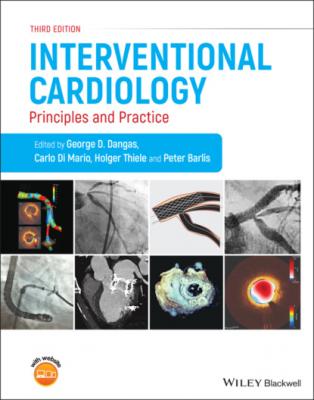Interventional Cardiology. Группа авторов
Читать онлайн.| Название | Interventional Cardiology |
|---|---|
| Автор произведения | Группа авторов |
| Жанр | Медицина |
| Серия | |
| Издательство | Медицина |
| Год выпуска | 0 |
| isbn | 9781119697381 |
Figure 4.7 These views were taken during primary angioplasty performed in a 41‐year‐old male who presented with an acute inferolateral myocardial infarction. No antegrade perfusion was evident in the circumflex territory (a to d), although retrograde collaterals to an obtuse marginal branch were seen in some views (green arrow, a). The right coronary artery (RCA) was occluded and filled retrogradely via the left anterior descending (LAD) (yellow arrow, a and b; d and e). The culprit lesion was in an aberrant circumflex arising from the right sinus (f). Following aspiration thrombectomy and stent deployment it was evident that the aberrant circumflex provided the principal collateral supply to a chronically occluded dominant RCA (yellow arrow, g).
Figure 4.8 Optimal angiographic views for specific segments in the circumflex and right coronary are indicated with a green tick mark. Some views that may be useful but are not generally recommended are indicated with an orange tick mark and inadequate views with a red cross.
Figure 4.9 This 47‐year‐old male with known coronary disease presented with deteriorating angina and reversible ischemia in the anterior territory on perfusion imaging. Conventional views (a–c) raised suspicion of a lesion in the left anterior descending (LAD) ostium due to haziness (a) but were limited by overlap at the ostium of the LAD due to unusual tortuosity (a). Unusual modification including a steep spider view and a lateral view with cranial angulation were required to delineate the lesion (d, e). The final angiographic result is shown after stenting (f).
Once the anomalous coronary vessel has been intubated the standard views are often sufficient for the mid and distal vessel if the heart has a normal position and orientation (Figures 4.2 and 4.3), while the views for the proximal vessel and ostium may need to be modified depending on the origin and course.
Ventriculography
Knowledge of ventricular function is essential to interpret the clinical relevance of coronary disease and planning appropriate treatment. Many patients have a contemporary assessment of left ventricular function by non‐invasive testing, which provides similar or superior definition of the left ventricular cavity volume and global and regional wall motion, with the advantage that most of them can also dynamically study wall thickness and tissue characteristics (echocardiography, magnetic resonance imaging, nuclear imaging) when attending for coronary angiography [1]. These modalities provide more information on the function and morphology of the left ventricle than conventional ventriculography and can obviate the need for further assessment. Ventriculography should be performed in the catheter laboratory if left ventricular function has not been assessed recently. The RAO view is standard, although an additional LAO view could be considered if assessment of the postero‐lateral wall, usually supplied by the circumflex, is likely to influence management.
Transplanted Heart
The guidelines for management of heart transplant recipients consider coronary angiography the gold standard method to detect cardiac allograft vasculopathy, which ranges from 42% at 5 years to 50% at 10 years. These patients do not experience typical angina due to the the denervation of the transplanted heart [9].
In patients with orthotopic heart transplant the coronary angiography is technically difficult due to the presence of the aortotomy with anomalous implantation of the coronary ostia and to the position of the allograft. A transfemoral approach is usually preferred and its superiority was confirmed in a small, randomized study. [10]
In heterotopic heart transplant the heart of the donor and recipient are sewed in a parallel fashion. Nowadays, its role is limited to the presence of high pulmonary hypertension in patients who cannot receive a combined heart and lung transplant or in the case of significant donor‐recipient body size mismatch. A 1994 study showed that the success cannulation rate was 67%, that the preferred access was the femoral and that the most helpful angiographic views were the posterior‐anterior, left anterior oblique, and caudal right anterior oblique [11].
Interactive multiple choice questions are available for this chapter on www.wiley.com/go/dangas/cardiology
References
1 1 Di Mario C, Sutaria N. Coronary angiography in the angioplasty era: projections with a meaning. Heart 2005; 91:968–976.
2 2 Secco GG, Agostoni PF. Coronary interventions: 5F versus 6F to 7F. In: Bertrand O, Rao S. (eds) Best Practice for Transradial Approach in Diagnostic Angiography and Intervention. Wolters Kluwer: 2015.
3 3 Israeli Z., Lavi S., Pancholy S.B., et al. Radial versus femoral approach for saphenous vein grafts angiography and interventions. Am Heart J 2019 Apr; 210:1–8
4 4 Cha KS, Kim MH. Feasibility and safety of concomitant left internal mammary arteriography at the setting of the right transradial coronary angiography. Catheter Cardiovasc Interv 2002; 56(2):188–195.
5 5 Akpinar I, Sayin MR, Karabag T, et al. Differences in sex, angiographic frequency, and parameters in patients with coronary artery anomalies: single‐center screening of 25 368 patients by coronary angiography. Coron Artery Dis 2013; 24:266–271.
6 6 Yuksel S, Meric M, Soylu K, et al. The primary anomalies of coronary artery origin and course: a coronary angiographic analysis of 16,573 patients. Exp Clin Cardiol 2013; 18:121–123.
7 7 Earls JP. Coronary artery anomalies. Tech Vasc Interv Radiol. 2006 Dec; 9(4):210–7.
8 8 Angelini P, Uribe C. Anatomic spectrum of left coronary artery anomalies and associated mechanisms of coronary insufficiency. Catheter Cardiovasc Interv. 2018 Aug 1; 92(2):313–321
9 9 Kittleson MM. and Kobashigawa JA. Cardiac Transplantation Current Outcomes and Contemporary Controversies. JACC: Heart Failure 5:12, December 2017
10 10 Scalone G, Brugaletta S, Martín‐Yuste V, et al. RAndomized Comparison of raDIal vs. femorAL Access for Routine Catheterization of Heart Transplant Patients (RADIAL‐heart transplant study). Transplant Proc. 2014 Dec; 46(10):3262–7
11 11 Lowry RW, Bitar JN, Grinstead WC, et al. Heterotopic heart transplantation: catheterization, endomyocardial biopsy,
